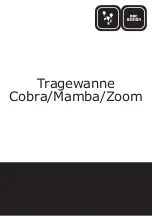
EcoBoost MPPT Operator's Manual
23
4.0
Installation
22
• the EcoBoost MPPT is in LVD (red LED on)
• there is a short circuit in the load (LEDs blinking R/G – Y)
• there is an overload condition (LEDs blinking R/Y - G)
• the load is not connected, not working, or turned off
After all connections have been completed, observe the
LEDs to make sure the controller is operating normally for
system conditions. If the optional digital meter is used,
observe that the display is scrolling with proper voltage
and current values. Also, a self- test can be performed with
digital meter units.
STEP 8:
To
Power-down
WARNING:
Risk of Damage
ONLY disconnect the battery from the
EcoBoost MPPT AFTER the solar input has been
disconnected. Damage to the controller may result if the
battery is removed while the EcoBoost MPPT is charging.
• To prevent damage, power-down must be done in the
reverse order as power-up.
4.1 TrakStar
TM
MPPT Technology
The EcoBoost MPPT utilizes Morningstar’s TrakStar
Maximum Power Point Tracking technology to extract
maximum power from the solar module(s). The tracking
algorithm is fully automatic and does not require user
adjustment. TrakStar technology will track the array
maximum power point voltage (Vmp) as it varies with
weather conditions, ensuring that maximum power is
harvested from the array through the course of the day.
High Voltage Strings and Grid-tie Modules
Another benefit of TrakStar MPPT technology is the ability
to charge 12 or 24 Volt batteries with solar arrays of higher
nominal voltages. A 12 Volt battery bank can be charged
with a 12, 24, 36 or 48V nominal off-grid solar array.
Certain grid-tie solar modules may also be used if the solar
array open circuit voltage (V
oc
) rating will not exceed the
EcoBoost MPPT 120V maximum input voltage rating at
worst-case (lowest) module temperature. The solar module
documentation should provide V
oc
vs. temperature data.
Higher solar input voltage results in lower solar input current
for a given input power. High voltage solar input strings
allow for smaller gauge solar wiring. This is especially helpful
for systems with long wiring runs between the solar array
and the EcoBoost MPPT.
4.2 Battery Charging
4-Stage Charging
The EcoBoost MPPT has a 4-stage battery charging
algorithm for rapid, efficient, and safe battery charging.
Figure 4-1 shows the sequence of stages.
4.0 OPERATION















































